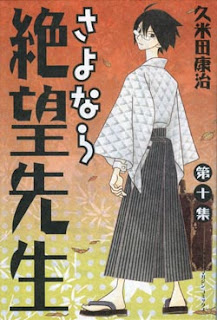I will be the first to admit it, I don't usually read gag manga. The whole point of there not being any real story or continuation throughout a manga is still something that throws my head for a little spin. I need action, suspense, plot even ( I know that's a shocking concept for some people). Yet I gotta say, Zetsubou was a pretty enjoyable read. Much smarter than I was expecting from a gag manga. The jokes were a little smarter and the numerous references that is shoved into this manga is pretty impressive.
More gag manga like this black comedy might need to be found in my near future.
I will not lie to you, I had absolutely no idea what this manga was about before I started reading it. All I knew was that it had an anime adaption and all the covers of the tankobons showcased a man and younger girls wearing historical dress. These two observations equated a historical drama in my brain. I mean really, what Japanese person wears a hakama for their regular dress nowadays? This is a very normal and logical assumption.
Little did I know. When I was created with the main male character trying to commit suicide within the first 3 pages, lets just say that I was thrown off and realized that my original expectation of this manga was not going to be coming true at all.
After reading the first 30 or so chapters in one sitting and laughing through most of it both surprised and delighted me. Finally, a manga that poked fun at not just the Japanese but the rest of the world. There are political, panty, cultural, logical, illogical, and everything under the sun kinda jokes in this manga. There were references to other manga, otaku culture, Michael Jackson showed up numerous times, the famous Adachi Mitsuru Touch quotes came out, and I'm pretty sure that every Prime Minister in the last 6 years was in this series at least twice for each other them. I laughed every time I saw them.
Kumeta is one very well read individual. The fact that most of his chapter titles are connected to famous quotes from Japanese and Western authors alone proves this fact, but the sheer amount of cultural capital that gushes out of every chapter of this 300+ chapter manga just reinforces that knowledge. From what I've read from the scanlations I could find, the translators had to create pages of translation notes so that readers would be able to follow and understand a bulk of that cultural capital. I am not a fan of Yukio Mishima's novels, but the fact that I could spot a quote of his in the chapters or a reference to Murakami in the text just impresses me even further. Of course, that might also be because I was coming into this series completely blind, except for the use of cover art as plot indicator.
You hear all the time that the Japanese themselves take their culture and history very seriously and that they don't understand the concept of irony, but this manga is proof that there is at least a small population of this country that does actually understand how to laugh at themselves. It's actually pretty refreshing when you think about it. While there are still some issues with sarcasm, the irony of life is getting through to some Japanese.
You hear all the time that the Japanese themselves take their culture and history very seriously and that they don't understand the concept of irony, but this manga is proof that there is at least a small population of this country that does actually understand how to laugh at themselves. It's actually pretty refreshing when you think about it. While there are still some issues with sarcasm, the irony of life is getting through to some Japanese.
While the harem of school girls with their very clique personalities were amusing for most of the first 50 or so chapters, I found myself getting pretty tired of them after that. The way that they interacted with the other characters and set each other up as the butt of the jokes was still entertaining on a service level, but I still enjoyed the manga more for the other references that were made. It also becomes obvious about chapter 100 that Kumeta created his own formula for how most chapters would be set up. The stalker is always surprisingly saying something for the teacher to say, "Oh, you were there?" every chapter got pretty old pretty fast.
That's the problem with gag manga. There is always a point where the formula is established and both the mangaka and the reader fall into this routine every chapter instead of something completely new and unexpected happening and the reader gets bored. I kept hoping that something would change in the routine, but alas it didn't in the chapters I have read. And after a while, it becomes obvious that the mangaka is also stretching each joke and each reaction for the 14 pages he had to fill. Gag manga with all this capital and cultural critiques runs out of material pretty fast when its a weekly serialization.
The manga is actually finishing soon, if not already finished in the magazine, I can only hope that the last chapters were epic in some way shape or form.

No comments:
Post a Comment